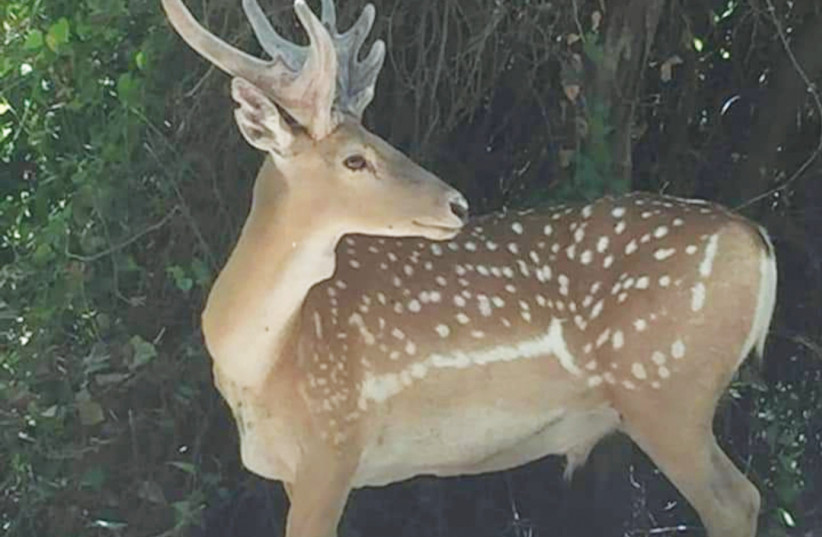An odyssey of espionage and revolutions led Israel to bring the once thriving biblical species back home, “one of the most successful cases of the reintroduction of a species extinct in the wild.”
By AARON REICH NOVEMBER 24, 2020 12:24
‘Deer #42’ was recently spotted, happy and healthy in the Jerusalem hills (photo credit: AMY KATZ)
Israel has one of the world’s two populations of Persian fallow deer – but it took a revolution, a clandestine Mossad mission, and a secret and daring flight for this to happen.
Persian fallow deer once thrived in Israel and are mentioned in the Bible. Known as Dama dama mesopotamica in Latin or Yahmor Parsi in Hebrew, it is believed to be the roebuck mentioned in the Bible as an animal that chews the cud and has cloven hooves, and hence is kosher (Deuteronomy 14:5). Moreover, it was obviously considered fit for a king, as it was served at King Solomon’s table (I Kings, 4:23).
As relayed by the official State of Israel Twitter account, the Persian fallow deer was considered extinct. But in the 1950s, a small population was discovered living in Iran.
After their discovery, Israel’s Nature and Parks Authority, headed by Six Day War hero Gen. Avraham Yoffe, worked hard to reintroduce the endangered species to the country, due to an Israeli initiative to restore biblical-era wildlife in Israel, according to scholarly research on the species.
This coincided with a breeding program in Germany’s Opel Zoo, which succeeded in breeding from a single pure-blooded female in 1960, though the male deer did not survive long enough to continue breeding efforts.
While the Jewish state managed to secure male deer from Germany, female specimens still eluded them. As such, Israel tried to arrange with the shah of Iran that two members of the small Persian fallow deer herd could be sent to Israel.
Their efforts included Yoffe working to court the shah’s brother, avid hunter Prince Abdol Reza Pahlavi, inviting him to the Negev to hunt Nubian ibex. The ibex is a protected species in Israel but then-agricultural minister Ariel Sharon made an exception, according to The Wall Street Journal – but no progress was made for nearly two decades.
According to WSJ, Yoffe himself went to Tehran to retrieve the deer on invitation from the shah’s brother, but had a mild heart attack on arrival.
According to Itzik Segev, Israel’s military attaché to Iran at the time, “As the general was being rolled onto the airplane on his stretcher, he turned to me, clutched my hand, and said, ‘Segev, you will get me those deer,'” The Wall Street Journal reported.
BUT EVERYTHING changed in December 1978. Sensing the impending revolution, the Nature and Parks Authority was called by the shah, who told them to immediately dispatch Mossad agents to secure the deer.
By the time the agent arrived – supposedly zoologist Mike Van Grevenbroek, armed reportedly with a blow-gun disguised as a cane according to The Wall Street Journal – nobody was there to greet him. The shah and his family had fled the country, and the agent was ordered to leave at once.
But all was not lost. As recounted by the Israel Twitter account, “By some form of divine intervention, the agent was able to locate the deer and bring them back to Israel, boarding the last Israeli flight to depart Iran.”
Indeed, the agent’s success in rounding up four females and bringing them back to Israel has led to some dubbing the operation “The Great Persian Deer Heist” – or by The Wall Street Journal as the Iranian “deerlift.”
And evidently, the mission was a big success for Yoffe as well.
“I arrived at the airport in Tel Aviv, unloaded the deer and there’s the big general waiting with tears in his eyes,” Van Grevenbroek said, according to the newspaper.
TODAY, conservation and breeding efforts by the Jerusalem Biblical Zoo and the Hai-Bar Carmel Nature Reserve have resulted in the Persian fallow deer making a comeback in their biblical homeland.
“Over the years, we have released tens of deer in the Nahal Soreq area,” explained Dr. Nili Avni-Magen, the zoological director and chief veterinarian at the Jerusalem zoo.
“In the last three years we have seen third-generation fawns, which have been born to mothers that themselves were born in the wild. The return of the Persian fallow deer to the Israeli landscape is one of the most successful cases of the reintroduction of a species that has become extinct in the wild.”
It was estimated in 2015 that the current global population of the deer was over 1,100 individuals, including those in the wild in Iran and Israel and those in captivity. In 2020, the Nature and Parks Authority estimated that 200-300 Persian fallow deer live in the northern Galilee region, while between 90 and 100 live in the Judean Hills and a few others live on Mount Carmel.
According to Haaretz, the reintroduction of captive-bred specimens to the wild is ongoing, and more are planned in 2021.
Liat Collins contributed to this report.

